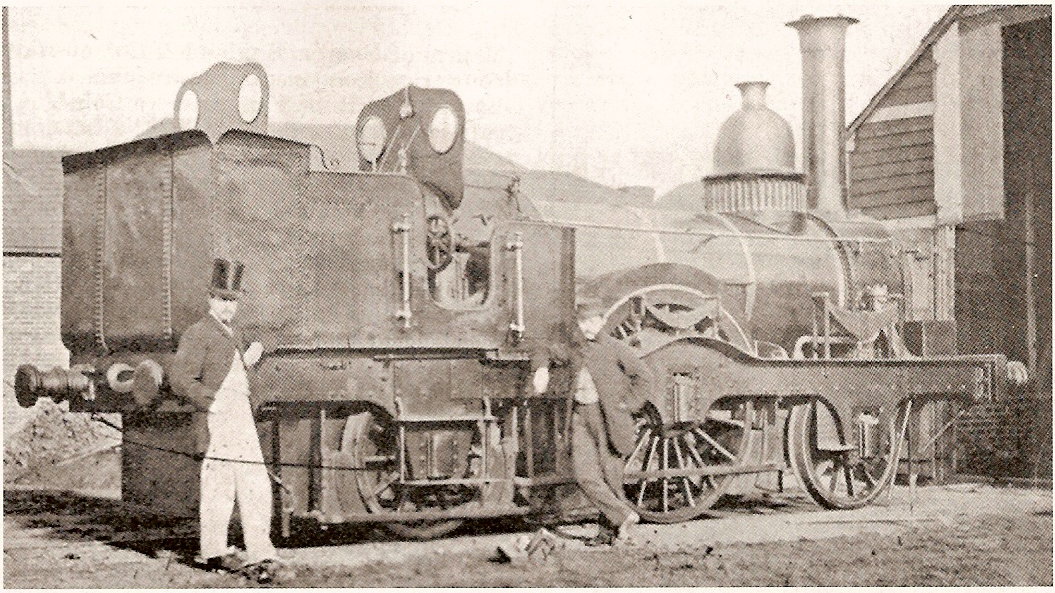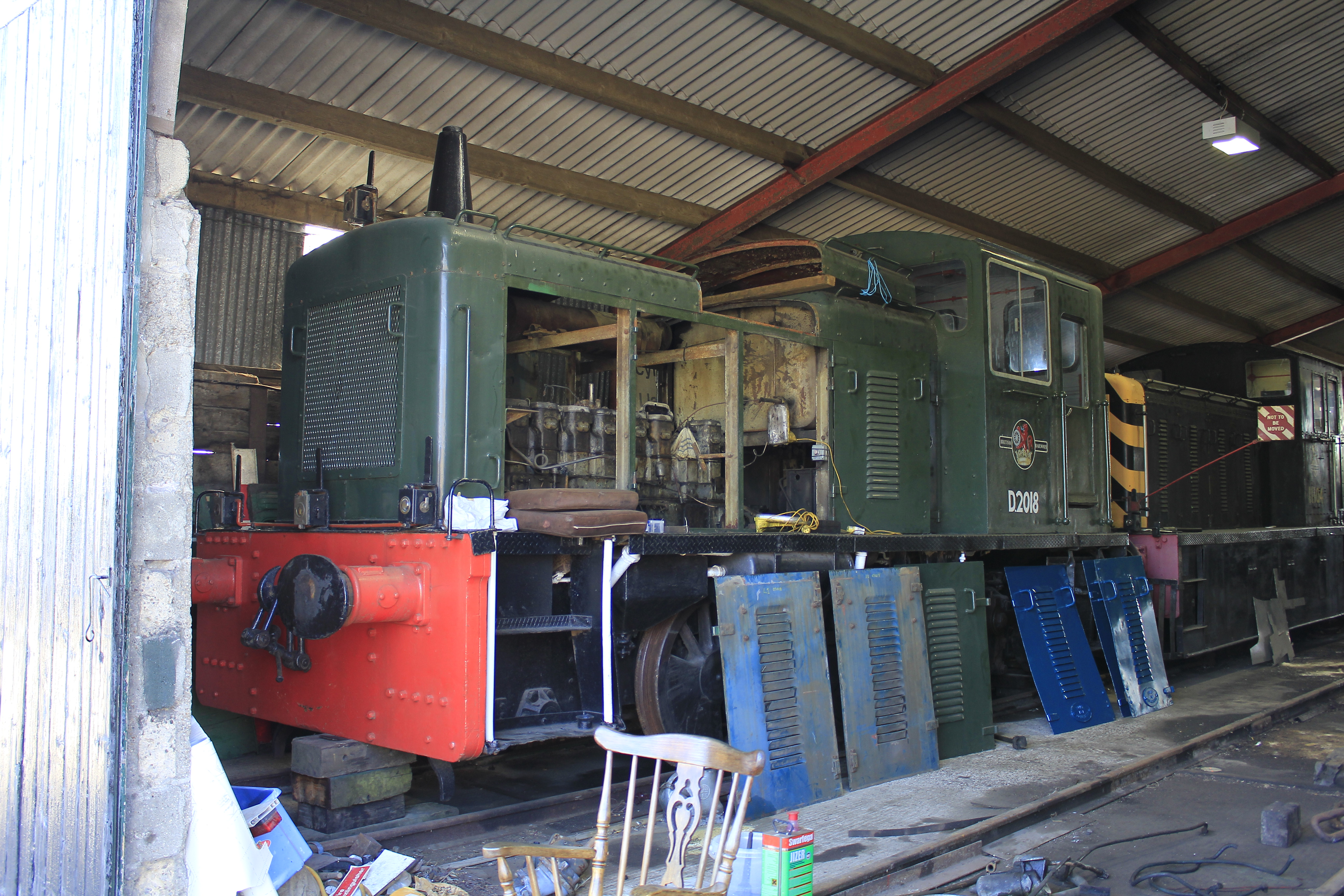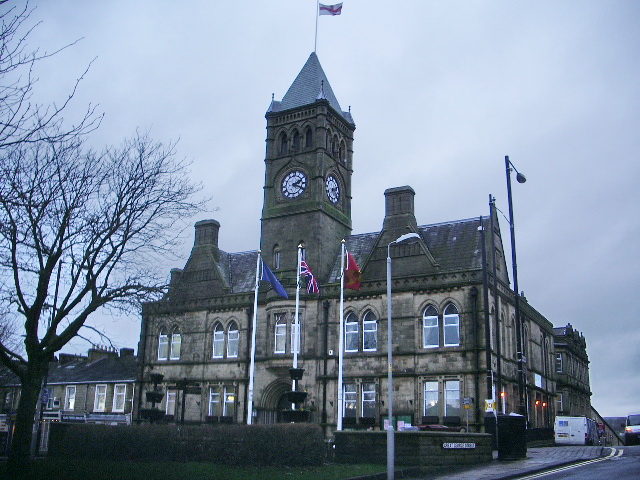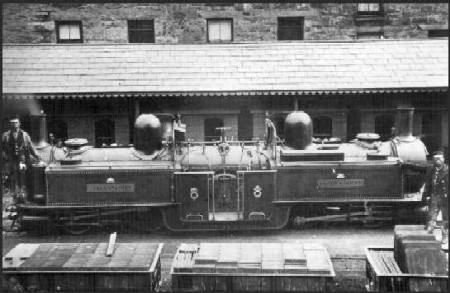|
Colne Valley Railway
The Colne Valley Railway is a heritage railway based at Castle Hedingham Station, near Halstead in Essex, England. The railway consists of a long running line, with a fully reconstructed station, signal box and railway yard. History The railway occupies part of the former Colne Valley and Halstead Railway (CVHR), which opened in stages between 16 April 1860 and 10 May 1863. This part of the railway was a through line from to Wakes Colne. The line closed on 1 January 1962, when all passenger and freight traffic between and ended. On 19 April 1965, all transiting freight traffic ended. The line was dismantled and infrastructure demolished or recovered by contractors a year later, and the land on which the heritage railway station now sits resold to a local landowner. Preservation The site was acquired from the landowner in 1973 and the Colne Valley Railway Company Limited formed to operate the railway. A volunteers' supporters body, the Colne Valley Railway Preservation ... [...More Info...] [...Related Items...] OR: [Wikipedia] [Google] [Baidu] |
Colne Valley And Halstead Railway
The Colne Valley and Halstead Railway (CVHR) is a closed railway between Haverhill, Suffolk and Chappel and Wakes Colne, Essex, in England. History A railway in the Colne Valley was first proposed in 1846 when the Colchester, Stour Valley, Sudbury and Halstead Railway Company was incorporated to build a line from Marks Tey on the Eastern Counties Railway to Sudbury, with a branch to Halstead and a line from Colchester to Hythe. A later extension to Bury St. Edmunds and Clare was also approved, however a shortage of funds resulted in only the Stour Valley Railway to Sudbury and the line to Hythe being built. In 1856, the Colne Valley and Halstead Railway Company was formed by local people to build a branch line from Chappel and Wakes Colne railway station to Halstead. It was authorised on 30 June 1856, and opened on 16 April 1860 between Chappel (north of Marks Tey) and Halstead, a distance of .Railway Magazine December 1958 p. 890 A extension was authorised on 13 Augus ... [...More Info...] [...Related Items...] OR: [Wikipedia] [Google] [Baidu] |
Ruston & Hornsby
Ruston & Hornsby was an industrial equipment manufacturer in Lincoln, Lincolnshire, Lincoln, England founded in 1918. The company is best known as a manufacturer of narrow gauge railway, narrow and standard gauge diesel locomotives and also of steam shovels. Other products included automobile, cars, steam locomotives and a range of internal combustion engines, and later gas turbines. It is now a subsidiary of Siemens. Background Proctor & Burton was established in 1840, operating as millwrights and engineers. It became Ruston, Proctor and Company in 1857 when Joseph Ruston joined them, acquiring limited liability status in 1899. From 1866 it built a number of four and six-coupled tank locomotives, one of which was sent to the Exposition Universelle (1867), Paris Exhibition in 1867. In 1868 it built five 0-6-0 tank engines for the Great Eastern Railway to the design of Samuel Waite Johnson. Three of these were converted to crane tanks, two of which lasted until 1952, aged eighty ... [...More Info...] [...Related Items...] OR: [Wikipedia] [Google] [Baidu] |
D2184 At The Colne Valley Railway
D, or d, is the fourth letter in the Latin alphabet, used in the modern English alphabet, the alphabets of other western European languages and others worldwide. Its name in English is ''dee'' (pronounced ), plural ''dees''. History The Semitic letter Dāleth may have developed from the logogram for a fish or a door. There are many different Egyptian hieroglyphs that might have inspired this. In Semitic, Ancient Greek and Latin, the letter represented ; in the Etruscan alphabet the letter was archaic, but still retained (see letter B). The equivalent Greek letter is Delta, Δ. Architecture The minuscule (lower-case) form of 'd' consists of a lower-story left bowl and a stem ascender. It most likely developed by gradual variations on the majuscule (capital) form 'D', and today now composed as a stem with a full lobe to the right. In handwriting, it was common to start the arc to the left of the vertical stroke, resulting in a serif at the top of the arc. This serif w ... [...More Info...] [...Related Items...] OR: [Wikipedia] [Google] [Baidu] |
D2041 At Colne Valley Railway
D, or d, is the fourth letter in the Latin alphabet, used in the modern English alphabet, the alphabets of other western European languages and others worldwide. Its name in English is ''dee'' (pronounced ), plural ''dees''. History The Semitic letter Dāleth may have developed from the logogram for a fish or a door. There are many different Egyptian hieroglyphs that might have inspired this. In Semitic, Ancient Greek and Latin, the letter represented ; in the Etruscan alphabet the letter was archaic, but still retained (see letter B). The equivalent Greek letter is Delta, Δ. Architecture The minuscule (lower-case) form of 'd' consists of a lower-story left bowl and a stem ascender. It most likely developed by gradual variations on the majuscule (capital) form 'D', and today now composed as a stem with a full lobe to the right. In handwriting, it was common to start the arc to the left of the vertical stroke, resulting in a serif at the top of the arc. This serif w ... [...More Info...] [...Related Items...] OR: [Wikipedia] [Google] [Baidu] |
British Rail Class 03
The British Rail Class 03 locomotive was, together with the similar Class 04, one of British Railways' most successful 0-6-0 diesel-mechanical shunters. 230 were built at Doncaster and Swindon works between 1957 and 1962, and were numbered D2000-D2199 and D2370-D2399 (later 03004 to 03399). D2370 and D2371 were used as departmental locomotives and originally numbered 91 and 92 respectively. Overview Like other shunters of this size, the Class 03 was built for light duties where a larger locomotive was not needed, especially for shunting at locomotive and carriage depots and as station pilots, or where larger or heavier locomotives could not be used. The reduction over time in the demand for shunting locomotives meant that they were progressively withdrawn from 1968 onwards, many being sold to private industry, including three that were exported to Belgium. However, some remained in service much longer, with two examples on the Isle of Wight lasting until 1993 (mainland exam ... [...More Info...] [...Related Items...] OR: [Wikipedia] [Google] [Baidu] |
British Rail
British Railways (BR), which from 1965 traded as British Rail, was a state-owned company that operated most of the overground rail transport in Great Britain from 1948 to 1997. It was formed from the nationalisation of the Big Four British railway companies, and was privatised in stages between 1994 and 1997. Originally a trading brand of the Railway Executive of the British Transport Commission, it became an independent statutory corporation in January 1963, when it was formally renamed the British Railways Board. The period of nationalisation saw sweeping changes in the railway. A process of dieselisation and electrification took place, and by 1968 steam locomotives had been entirely replaced by diesel and electric traction, except for the Vale of Rheidol Railway (a narrow-gauge tourist line). Passengers replaced freight as the main source of business, and one-third of the network was closed by the Beeching cuts of the 1960s in an effort to reduce rail subsidies. On privatis ... [...More Info...] [...Related Items...] OR: [Wikipedia] [Google] [Baidu] |
Colne Valley Railway Preservation Society (2)
Colne () is a market town and civil parish in the Borough of Pendle in Lancashire, England. Located northeast of Nelson, north-east of Burnley, east of Preston and west of Leeds. The town should not be confused with the unrelated Colne Valley around the River Colne near Huddersfield in West Yorkshire. Colne is close to the southern entrance to the Aire Gap, the lowest crossing of the Pennine watershed. The M65 terminates west of the town and from here two main roads take traffic onwards towards the Yorkshire towns of Skipton (A56) and Keighley (A6068). Colne railway station is the terminus of the East Lancashire railway line. Colne adjoins the Pendle parishes of Foulridge, Laneshaw Bridge, Trawden Forest, Nelson, Barrowford and Blacko. History Settlement in the area can be traced back to the Stone Age. A Mesolithic camp site, a Bronze Age burial site and stone tools from the Bronze and Stone Ages have been discovered at nearby Trawden. There are also the remains of an I ... [...More Info...] [...Related Items...] OR: [Wikipedia] [Google] [Baidu] |
Robert Stephenson And Hawthorns
Robert Stephenson and Hawthorns Ltd (RSH) was a locomotive builder with works in North East England. History The company was formed in September 1937 when Robert Stephenson and Company, which was based in Darlington, took over the locomotive building department of Hawthorn Leslie and Company, based in Newcastle upon Tyne. The goodwill of Leeds locomotive builders Kitson & Co. was obtained in 1938. RSH locomotive numbering began at 6939, this being the first number following the sum total of locomotives built by Robert Stephenson & Co. and Hawthorn Leslie, (6938). RSH became part of English Electric in 1955. Locomotive building at the Newcastle upon Tyne works ended in 1961 and at Darlington in 1964. Diesel locomotives RSH entered the diesel locomotive market in November 1937 with a "direct reversing" locomotive fitted with a Crossley two-stroke engine. There was no reversing gearbox and the diesel engine itself was reversible, as in marine practice. When starting, in e ... [...More Info...] [...Related Items...] OR: [Wikipedia] [Google] [Baidu] |
CVR 0-6-0 Saddle Tank Engine -4
__NOTOC__ CVR may refer to: Business and economics * Central Business Register (Denmark), the Danish government register of businesses * Contingent value rights, in corporate finance, rights granted by an acquirer to a company’s shareholder * Conversion rate, term used to calculate website visitors in Internet marketing Transport * Churnet Valley Railway, a heritage railway in Staffordshire, England * Cimarron Valley Railroad, a railway track in the United states * Cockpit voice recorder, a type of aircraft flight recorder that records audio information * Colne Valley Railway, a heritage railway in Essex, England * Combat Vehicle Reconnaissance — two British armoured vehicle series: **Combat Vehicle Reconnaissance (Tracked), or CVR(T) **Fox armoured reconnaissance vehicle, or CVR(W) * C.V.R. (automobile), French car manufacturer (1906–1907) * CVR, the ICAO airline designator for Chevron, United States Other * ''Charlie Victor Romeo'', a 1999 play and 2013 film * ... [...More Info...] [...Related Items...] OR: [Wikipedia] [Google] [Baidu] |
Hawthorn Leslie And Company
R. & W. Hawthorn, Leslie and Company, Limited, usually referred to as Hawthorn Leslie, was a shipbuilder and locomotive manufacturer. The company was founded on Tyneside in 1886 and ceased building ships in 1982. History The company was formed by the merger of the shipbuilder A. Leslie and Company in Hebburn with the locomotive works of R and W Hawthorn at St. Peter's in Newcastle upon Tyne in 1886. The company displaced its locomotive manufacturing interests in 1937 to Robert Stephenson and Company, which became ''Robert Stephenson and Hawthorns Ltd.'' Perhaps the most famous ship built by the Company was HMS ''Kelly'', launched in 1938 and commanded by Lord Louis Mountbatten. In 1954, the shipbuilding and marine engine activities were put into separate subsidiaries, Hawthorn Leslie (Shipbuilders) Ltd. and Hawthorn Leslie (Engineers) Ltd. In 1968 the Company's shipbuilding interests were merged with that of Swan Hunter and the Vickers Naval Yard to create Swan Hunter & Tyne ... [...More Info...] [...Related Items...] OR: [Wikipedia] [Google] [Baidu] |
Avonside Engine Company
The Avonside Engine Company was a locomotive manufacturer in Avon Street, St. Philip's, Bristol, England between 1864 and 1934. However the business originated with an earlier enterprise Henry Stothert and Company. Origins The firm was originally started by Henry Stothert in 1837 as Henry Stothert and Company. Henry was the son of George Stothert (senior), founder of the nearby Bath engineering firm of Stothert & Pitt. Henry's brother, also named George, was manager of the same firm. The company was given an order for two broad gauge () Firefly class express passenger engines ''Arrow'' and ''Dart'', with driving wheels, delivered for the opening of the Great Western Railway (GWR) from Bristol to Bath on 31 August 1840. This was soon followed by an order for eight smaller Sun class engines with driving wheels. Stothert, Slaughter and Company Edward Slaughter joined the company in 1841, when it became known as Stothert, Slaughter and Company. By 1844 their works were n ... [...More Info...] [...Related Items...] OR: [Wikipedia] [Google] [Baidu] |




.jpg)


